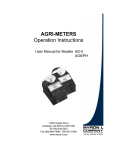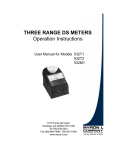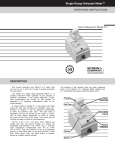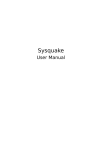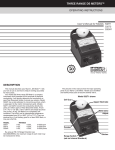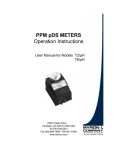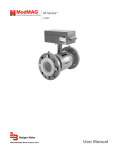Download ControlStik 595 Manual
Transcript
CONTROLSTIK RINSE TANK SYSTEM Installation • Operation• Maintenance User Manual for Model 595 2450 Impala Drive Carlsbad, CA 92010-7226 USA Tel 760-438-2021 Fax 800-869-7668 / 760-931-9189 www.myronl.com pH/Conductivity Instrumentation Accuracy • Reliability • Simplicity PLEASE READ THIS THROUGH COMPLETELY BEFORE ATTEMPTING TO INSTALL OR OPERATE THIS SYSTEM. 2. DESCRIPTION The Myron L Controlstik Rinse Tank System is a fully automatic control which will greatly reduce the amount of water used in continuous flow rinse tanks. At the same time, it automatically maintains water quality, ensuring effective rinsing in water up to 180°F (82°C). It operates on the electrical conductivity principle and is fully stable and protected against all environmental conditions including temperature, line voltage, water contamination and corrosion. Controlstik Sensor Hang Controlstik (sensor) in the tank by the cord, using the secured clamp to hold the cord onto the edge of the tank. The sensor should hang vertically, fully submerged at least 4 inches (100 mm) off the tank bottom and not closer than 2 feet (61 cm) to the inlet water line. If tank is small, locate sensor at end opposite from inlet. NOTE: If water rate is slow or if dragin rate and concentration prevent good diffusion of contamination … the following should be considered to ensure the Controlstik senses water which is “representative” of the entire tank: a. Agitation — by air or other means After installation, the Controlstik (sensor) is submerged in the rinse water. When contamination (dragin) accumulates beyond the point “safe” for good rinsing, the sensor automatically opens the Solenoid Valve. Fresh water flows into the tank, and as excessive contamination is diluted back to the “safe” level, the sensor closes the valve, limiting water use. b. Installation of weir in tank perpendicular to water flow c. Use of spider (sparge) on inlet INSTALLATION AND OPERATION PROCEDURES A. Mounting 1. Transformer Box NOTE: 115 VAC Models, see Section C.1 before proceeding. CAUTION: Do not apply power until all wiring has been completed and connections checked. a. For panel mounting, cut 3.96 in. (101 mm) x 5 in. (127 mm) hole in panel (template on back page can be used). Drill two holes in panel. Holes should be .089 in. (2.3 mm) if using self-tapping screws; .113 in. (2.9 mm) if using bolts/ nuts provided. Attach to panel through lower (without brass inserts) box flange holes. b. If surface mounting, first attach the supplied Surface Mounting Plate to the rear of the transformer box with the two (2) 1/4" - 20 screws provided. Use appropriate screws or bolts (not provided) to then mount the box/plate assembly to a suitable surface. c. Following electrical connections detailed below, front face plate is snapped on (gasket seal requires some pressure) and attached using black screws (provided). B. Piping 1. Install valve in inlet water line to rinse tank so that flow direction is as indicated by the arrows on the top of valve body. 2. Use Teflon tape on all connections and plug the unused inlet. 3. Ensure flow control is at least partially open by turning counterclockwise. NOTE: The 1-inch NPT valve supplied requires at least 10 psi (69 kPa) line pressure to operate. Increasing flow rate may allow valve to operate at lower pressure. C. Wiring NOTE: 1. 2. 115 VAC systems — proceed to Section C.4 below. For 230 VAC systems: remove four screws in base plate and lift out entire transformer electronics assembly. 4. Remove “short” between electrodes. VALVE light will go out and valve will shut off. E. Initial Setting and Operation If it is permissible for power line to share same opening as valve and Controlstik sensor cables, this is easiest method. If the 230 VAC power line must be separate, CAREFULLY cut the edges of the preferred “knockout” with a sharp knife to remove. The power line should then be attached to the two transformer leads with wire nuts. Be certain to also attach earth to the screw on the side of the transformer. 1. Fill pail with water from rinse tank inlet water line. 2. Move inside probe of the Controlstik (sensor) back to highest scale reading and submerge into pail of water. 3. Slowly push inside probe toward opposite end, stopping when Solenoid Valve triggers and VALVE light goes on. Water will begin to flow into the tank. Read scale. 3. Return transformer electronics assembly to box and screw down baseplate. 4. 4. Insert Controlstik cable through the slotted plastic plus in box side. Connect the four color coded wires to the terminals marked CONTROLSTIK. For the initial setting, move the inside probe back to read at least 25% higher than the scale reading in step 3. Tighten set screw with 9/64" Allen wrench (finger tight is not sufficient). 5. Obtain enough low voltage wire (at least 20 gauge/ .9398 mm diameter) to connect solenoid valve to Transformer Box. Use pliers to attach spade lugs (provided) to wire. Connect lugs to terminal strip screws in box marked VALVE as in diagram. Place the Controlstik (sensor) back into the rinse tank as described under Section A. Mounting, number 2. Fasten the cord with the securing clamp provided. 6. Recheck to be certain all connections are to correct terminals. Check setting and overall operation by rinsing parts or by pouring a small amount of acid or alkaline solution into the rinse tank to trigger the Solenoid Valve and start water flow. 7. Adjust valve flow control handle to obtain desired flow rate. Check through at least one complete on/off cycle. This valve can also be operated manually. To disengage the solenoid (convert valve to manual operation) hold the cross handle firmly and loosen (counterclockwise) the bolt in the center of the stem. Some water will spurt out at the stem while it is under manual control. 5. 6. CAUTION: D. to “short” the inside cone electrode to the outside band electrode. This “short” will turn on valve; VALVE light on Transformer Box will glow and valve will open. DO NOT short or connect the Controlstik (sensor) to the terminals marked VALVE; damage may result. Testing 1. 2. If controlling ordinary tap water, make sure Transformer Box range toggle switch is set on “Hl” (toward back of box). If controlling purified (such as deionized) water, switch should be forward in “LO” position. Also, Controlstik sensor pointer should face in direction of High (500-5000 micromhos) or Low (5-500) scale to agree with Box range switch setting. To change pointer loosen set screw with 9/64 inch Allen wrench. Turn pointer to opposite scale. Lift the rod to the other side of the set screw and place back under the wide part of the pointer plate. Retighten set screw with fingers, allowing inside probe to move within sheath. Turn on the power by connecting the transformer box to 115 Volt AC (or correct voltage for model being installed). POWER light on Transformer Box will glow. NOTE: The best Controlstik (sensor) setting can be determined with experience. Since the main objective of the system is to conserve water use, a high conductivity setting on the sensor is desirable … as long as the water does not become too dirty, preventing effective rinsing. However, if the sensor is set too low, the water will flow continuously due to the normal conductivity (total dissolved solids) in source water - defeating the purpose of the system. MAINTENANCE A. Controlstik (sensor) Although this system is very stable, the sensor should be regularly checked for hard water scale, which will lower its sensitivity. Scale can be easily removed by agitating sensor in a 2-10% hydrochloric acid solution. If scale has been allowed to build up for a long period, a bristle brush may also be used. The Controlstik (sensor) may be disassembled by removing the set screw and thoroughly cleaned if it should accidentally become completely fouled. B. Valve Should the Controlstik Rinse Tank System no longer activate the Solenoid Valve when the inside probe is intentionally “shorted,” unscrew the solenoid from the side of the valve and check the chamber for any solid matter which may prevent easy solenoid movement. 3. Bring Controlstik (sensor) electrodes together by sliding the inside probe completely forward. Use a screwdriver WARRANTY This Myron L CONTROLSTIK System has a two-year warranty. If this system fails to function normally, return the faulty unit of the system to the factory prepaid. If in the opinion of the factory, failure was due to materials or workmanship, repair or replacement will be made without charge. A reasonable service charge will be made for diagnosis or repairs due to normal wear, abuse or tampering. Warranty is limited to the repair or replacement of the units of the CONTROLSTIK System only. The Myron L Company assumes no other responsibility or liability. pH Conductivity Instrumentation Accuracy • Reliability • Simplicity 2450 Impala Drive Carlsbad, CA 92010-7226 USA Tel 760-438-2021 Fax 800-869-7668 / 760-931-9189 www.myronl.com







